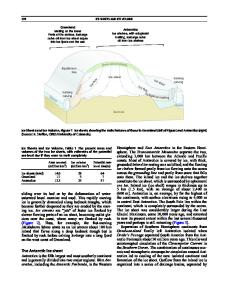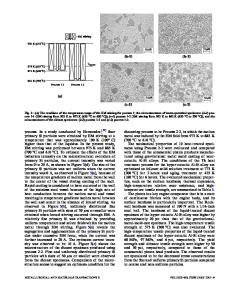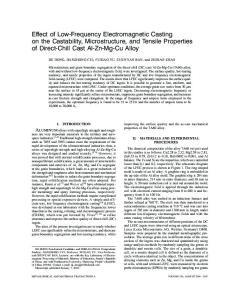Effects of the intensity and frequency of electromagnetic vibrations on the microstructural refinement of hypoeutectic A
- PDF / 3,183,227 Bytes
- 8 Pages / 612 x 792 pts (letter) Page_size
- 61 Downloads / 286 Views
INTRODUCTION
MICROSTRUCTURAL refining of metallic alloys has been the subject of numerous researches in the field of metallurgy. The reason lies in the fact that many of the mechanical properties of the alloy largely depend on the size and distribution of grains in the microstructure. Different methods have been used for this purpose. Particularly, the adoption of different combinations of electric and/or magnetic fields, which are stationary and/or alternating, has been of particular interest for almost 2 decades.[1,2,3] Certain combinations of these fields are able to induce electromagnetic forces that can act as powerful vibrating forces in the melt and affect the solidification microstructure on a microscopic scale. However, the abilities of these powerful forces are not fully investigated so far. In a recent work, Vives studied the effects of electromagnetic vibrations induced by the interaction of alternating electric and stationary magnetic fields during the solidification of aluminum alloys and reported considerable structural refinements after a threshold electromagnetic pressure where the cavitation phenomenon was likely to occur.[4] The cavitation phenomenon, which is widely studied in the field of ultrasonic technology[5,6,7] and not well practiced in metallurgy due to the difficulties arising from the implementation of ultrasonic devices at high temperatures, can be generated by electromagnetic vibrations. In a previous work[8] which was conducted on the effects of electromagnetic vibrations in a hypereutectic Al-Si alloy containing ALIREZA RADJAI, Advanced Materials Processing Research Scientist, Japan Science and Technology Corp., and KENJI MIWA, Head of Advanced Processing Lab., are with the National Industrial Research Institute of Nagoya, AIST, MITI, Kita-ku, Nagoya, Japan 462-8510. Manuscript submitted May 25, 1999. METALLURGICAL AND MATERIALS TRANSACTIONS A
suspended silicon particles, the solidification process was interrupted at different stages by water quenching and the mechanism of the microstructural refinement under electromagnetic vibrations was studied. Photomicrographs of the quenched samples showed that the cavitation phenomenon had been the main reason behind the refinement of primary silicon particles. The purpose of the present research is to study the effects of the two main parameters involved in the process of microstructural refinement by electromagnetic vibrations, that is, the intensity and frequency of vibrations. For this purpose, an experimental apparatus based on a superconducting magnet was designed and assembled, which enabled the imposition of a high electromagnetic pressure in the melt. The amplitude and frequency of vibrations could be regulated through an electric current source, and water nozzles installed around the sample enabled water quenching. Vibrations of different intensities and frequencies were induced in an Al-7 wt pct Si alloy melt during solidification and the results are analyzed and discussed. II. THEORETICAL BACKGROUND The simultaneous imposition o
Data Loading...











